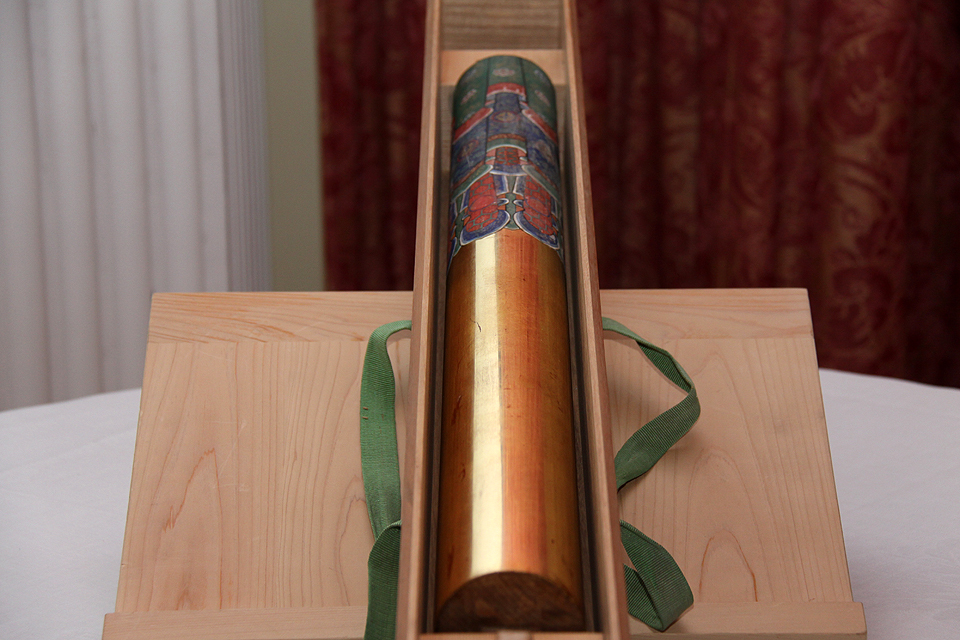Magnificent model of Japanese architectural treasure returns to Tokyo
The Meiji model of Taitokuin Mausoleum goes on display in Japan for the first time.

(from the left)MR WILLIAM H. COALDRAKE, Project Professor of The Graduate School of the University of Tokyo, BISHOP TATSUYU TOMODA, Chief Secretary of Zojo-ji Temple,MR JONATHAN MARSDEN, Director of Royal Collection Trust, TIM HITCHENS, British Ambassador to Japan
A spectacular 1:10 scale model of one of Tokyo’s most important lost architectural treasures has returned to Japan after more than 100 years. Part of the British Royal Collection, the model represents the Taitokuin Mausoleum, the memorial to Tokugawa Hidetada (1579 –1632), the second Tokugawa Shogun. Following painstaking restoration by Japanese craftsmen and women for the past twelve months, it will go on long-term display at the Zojo-ji Temple in Tokyo (formerly Edo), where the original building once stood, by gracious permission of Her Majesty Queen Elizabeth II. The model will form the centrepiece of an exhibition (open to the public from 2 April) to commemorate the 400th anniversary of the death of the founding Tokugawa Shogun.
The Taitokuin Mausoleum was built in 1632 in the precincts of the Tokugawa family temple of Zojo-ji, taking its name from Tokugawa Hidetada’s priestly title. The building became a pattern for all subsequent mausoleum architecture, in particular its unique exploitation of every surface for decoration. The Mausoleum was destroyed by wartime bombing of Tokyo in 1945.
The model was commissioned by the City of Tokyo for the 1910 Japan-British Exhibition in London, where it was displayed along with 13 other smaller-scale models of historic Japanese buildings. It was created by a team of the finest carpenters, lacquer artists and sculptors under the supervision of experts at Tokyo Art School, including the famous sculptor Takamura Koun. At 3.6 metres wide, 5.4 metres long and 1.8 metres high, it was five times larger than most of the other models commissioned for the exhibition.
The model replicates in intricate and colourful detail, both inside and out, the three interlocking buildings of the Taitokuin Mausoleum complex – the Main Hall (honden), Worship Hall (haiden), and Connecting Hall (ainoma). It faithfully incorporates the materials and techniques used in the Mausoleum, including thousands of miniature copper roof tiles, each the size of a thumb-nail.
Conservation work in Tokyo has focussed on the Main Hall, including repairing and cleaning the roof tiles, lacquered timber framing and doors, bamboo blinds, the Tokugawa family crests and the gilded wall paintings of the paradise of the Amida Buddha. The two Pillars of Paradise (Raigo-bashira), which flank the main altar, have also been carefully restored. The large fence (sukibei) that surrounded the Mausoleum has been cleaned and reassembled.
The Japan-British Exhibition, which took place at White City, London, from 14 May to 29 October 1910, was the largest international exposition that Japan had participated in. It aimed to project a progressive image of the country to the British and enhance trade between the two nations. The exhibition included demonstrations of Japanese crafts, music, sports and entertainments and was visited by more than eight million people, including Their Majesties King George V and Queen Mary. The model was subsequently presented to the King and for many years was on public display at Royal Botanical Gardens, Kew.
Tim Hitchens, British Ambassador to Japan, said:
I am absolutely delighted that, after so many years, the Taitokuin model is returning to Japan. In 2008 His Royal Highness The Prince of Wales visited Japan and presented one of the model’s pillars (Raigo-bashira) to the Vice Abbott of Zojo-ji temple. Now the whole model is back. It is a wonderful symbol of the way in which Britain and Japan can work together to bring to the wider public exceptional craftsmanship of profound historical and political significance. The model brings back to life what was lost in flames and thought irretrievable.
Jonathan Marsden, Director, Royal Collection Trust, said:
The significance of this extraordinary model has greatly increased, owing to the loss of the original building and its site. On behalf of Her Majesty Queen Elizabeth II, I am responsible for the care of this magnificent work of art in the Royal Collection, so I am delighted that, thanks to this remarkable partnership between Royal Collection Trust and Zojo-ji, the model is being restored by the very best craftsmen so that the people of Tokyo can fully appreciate one of the great architectural glories of Edo.
Bishop Tatsuyu Tomoda, Chief Secretary, Zojo-ji Temple said:
It brings me heartfelt joy that by the gracious permission of Her Majesty Queen Elizabeth II, the model of the Taitokuin Mausoleum will be returning to Japan after more than 100 years for public display at Zojo-ji Temple from 2 April. The model is a precious artefact documenting the earlier years of Zojo-ji, which has evolved as the Tokugawa Shogun’s family temple, and I would like to express my gratitude to the British Royal Collection Trust, the British Embassy in Tokyo and to everyone who made its restoration and exhibition a reality.

The Pillar of Paradise